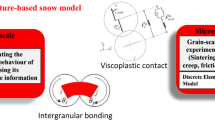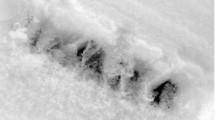Abstract
A micro-scale modelling approach of snow based on the extension of the classical discrete element method has been presented in the first part of this study. This modelling approach is employed to predict the mechanical response of snow under compression dependent on strain rate, initial density and temperature. Results obtained under a variety of conditions are validated with experimental data for both micro- and macro-scale, in particular the broad range between ductile i.e. low deformation rates and brittle i.e. high deformation rates regimes are investigated. For this purpose snow is assumed to be composed of ice grains that are inter-connected by a network of bonds between neighbouring grains. This arrangement represents the micro-scale of which the interaction is described by inter-granular collision and bonding. Hence, the response on a macro-scale is largely determined by inter-granular collisions and deformation and failure of bonds during a loading cycle. Consequently, validation was first carried out on micro-scale deformations at different loading rates and temperatures. Hereafter, macro-scale simulations of confined and unconfined, deformation-controlled compression tests have been predicted and were successfully compared to experimental data reported in literature.
Graphic abstract


















Similar content being viewed by others
References
Abele, G., Gow, A.: Compressibility characteristics of compacted snow. Technical Report. U.S. Cold Regions Research and Engineering Laboratory (1976)
Akkok, M., Ettles, C.M.M., Calabrese, S.J.: Parameters Affecting the Kinetic Friction of Ice. Journal of Tribology 109, 552–559 (1987). https://asmedigitalcollection.asme.org/tribology/article-pdf/109/3/552/5696634/552_1.pdf
Barnes, P., Tabor, D., Walker, J.C.F., F.R.S.: The friction and creep of polycrystalline ice. In: Proceedings of the Royal Society of London. Series A, Mathematical and Physical Sciences Proc. Roy. Soc. Lond. A, pp. 127–155
Chandel, C., Srivastava, P.K., Mahajan, P.: Micromechanical analysis of deformation of snow using X-ray tomography. Cold Reg. Sci. Technol. 101, 14–23 (2014)
Chiaia, B., Cornetti, P., Frigo, B.: Triggering of dry snow slab avalanches: stress versus fracture mechanical approach. Cold Reg. Sci. Technol. 53, 170–178 (2008)
Fukue, M.: Mechanical performance of snow under loading. Tokai University Press, Tomigaya (1979)
Gammon, P.H., Kiefte, H., Clouter, M.J., Denner, W.W.: Elastic constants of artificial and natural ice samples by brillouin spectroscopy. J Glaciol 29, 433–460 (1983)
Gaume, J., Chambon, G., Eckert, N., Naaim, M.: Influence of weak-layer heterogeneity on snow slab avalanche release: application to the evaluation of avalanche release depths. J Glaciol 59, 423–437 (2013)
Gaume, J., Chambon, G., Reiweger, I., Herwijnen, A.V., Schweizer, J.: On the failure criterion of weak-snow layers using the discrete element method. In: Proceedings International Snow Science Workshop (ISSW 2014),Banff, Alberta, Canada, 681–688, (2014)
Gaume, J., Schweizer, J., van Herwijnen, A., Chambon, G., Reuter, B., Eckert, N., Naaim, M.: Evaluation of slope stability with respect to snowpack spatial variability. J. Geophys. Res. Earth Surf. 119, 1783–1799 (2014. https://agupubs.onlinelibrary.wiley.com/doi/pdf/10.1002/2014JF003193
Gaume, J., Van Herwijnen, A., Chambon, G., Birkeland, K.W., Schweizer, J.: Modeling of crack propagation in weak snowpack layers using the discrete element method. Cryosphere 9, 1915–1932 (2015)
Hagenmuller, P., Chambon, G., Naaim, M.: Microstructure-based modeling of snow mechanics: a discrete element approach. Cryosphere 9, 1969–1982 (2015)
Heierli, J., Gumbsch, P., Zaiser, M.: Anticrack nucleation as triggering mechanism for snow slab avalanches. Science 321, 240–243 (2008). https://science.sciencemag.org/content/321/5886/240.full.pdf
Hertz, H.: 1881 Über die Berührung fester elastischer Körper. Journal für die reine und angewandte Mathematik 92, 156–171 (1881)
Kabore, B., Peters, B., Willibald, C., Thiele, T., Schneebeli, M.: Multi-scale modelling of snow mechanics. In: 41st Solid Mechanics Conference (SOLMECH 2018), Warsaw, Poland (2018)
Kabore, B.W., Peters, B.: Micromechanical model for sintering and damage in viscoelastic porous ice and snow. Part I: Model and calibration. Int. J. Solids Struct. 185-186, 324–333 (2020a). ar**v:1808.04394
Kabore, B.W., Peters, B.: Micromechanical model for sintering and damage in viscoelastic porous ice and snow. part ii: Validation. Int. J. Solids Struct. 185–186, 281–291 (2020b)
Kinosita, S.: Compression of snow at constant speed. In: International Conference on Low Temperature Science: Physics of Snow and Ice. pp. 911–927 (1967)
Löwe, H., Zaiser, M., Mösinger, S., Schleef, S.: Snow mechanics near the ductile-brittle transition: Compressive stick-slip and snow microquakes. Geophysical Research Letters 47, e2019GL085491. E2019GL085491 https://doi.org/10.1029/2019GL085491 (2020). https://agupubs.onlinelibrary.wiley.com/doi/pdf/10.1029/2019GL085491
von Moos, M.: Untersuchungen ”uber das visko-elastische verhalten von Schnee auf der Grundlage von triaxialen Kriechversuchen. Ph.D. thesis. ETH Z”urich (2001)
Morland, L.W.: Primary, secondary and tertiary creep of ice modelled as a viscoelastic fluid. J. Glaciol., 55, 170–178 (2009)
Narita, H.: An experimental study on tensile fracture of snow. Contributions from the Institute of Low Temperature Science, A32, 1–37 (1984)
Peters, B., Willibald, C., Theile, T.: SnowDEM meeting 2 - Luxembourg, July 2017, 1–3 (2017)
Rycroft, C.H.: Multiscale modeling in granular flow. PhD (2007)
Scapozza, C., Bartelt, P.: Triaxial tests on snow at low strain rate. Part II. Constitutive behaviour. J. Glaciol. 49, 91–101 (2003)
Szabo, D., Schneebeli, M.: Subsecond sintering of ice. Appl. Phys. Lett. 90, 151916 (2007)
Varrette, S., Bouvry, P., Cartiaux, H., Georgatos, F.: Management of an academic hpc cluster: The ul experience. In: 2014 International Conference on High Performance Computing Simulation (HPCS), pp. 959–967 (2014)
Von Moos, M., Bartelt, P., Zweidler, A., Bleiker, E.: Triaxial tests on snow at low strain rate. Part I. Experimental device. J. Glaciol. 49, 81–90 (2003)
Yong, R., Fukue, M.: Performance of snow in confined compression. J. Terramech. 14, 59–82 (1977)
Yong, R.N., Metaxas, I.: Influence of age-hardening and strain-rate on confined compression and shear behaviour of snow. J. Terramech. 22, 37–49 (1985)
Acknowledgements
The presented research project is financed by the National Research Fund of Luxembourg (FNR). Simulations were carried out with the High-Performance-Computing facilities (HPC) of the University of Luxembourg, see [27].
Author information
Authors and Affiliations
Corresponding author
Ethics declarations
Conflict of interest
The authors declare that they have no known competing financial interests or personal relationships that could have appeared to influence the work reported in this paper.
Additional information
Publisher's Note
Springer Nature remains neutral with regard to jurisdictional claims in published maps and institutional affiliations.
Rights and permissions
About this article
Cite this article
Peters, B., Kabore, B.W., Michael, M. et al. A discrete element framework for modeling the mechanical behaviour of snow Part II: model validation. Granular Matter 23, 43 (2021). https://doi.org/10.1007/s10035-020-01084-0
Received:
Accepted:
Published:
DOI: https://doi.org/10.1007/s10035-020-01084-0




